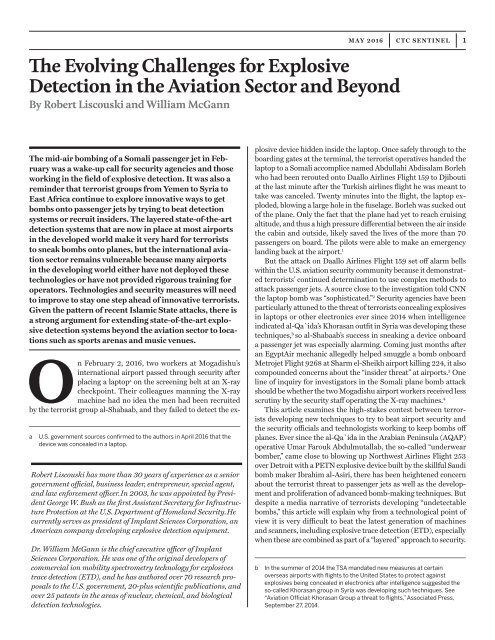The Challenges of Explosive Detection
CTC-SENTINEL_Vol9Iss58
CTC-SENTINEL_Vol9Iss58
Create successful ePaper yourself
Turn your PDF publications into a flip-book with our unique Google optimized e-Paper software.
<strong>The</strong> Evolving <strong>Challenges</strong> for <strong>Explosive</strong><br />
<strong>Detection</strong> in the Aviation Sector and Beyond<br />
By Robert Liscouski and William McGann<br />
MAY 2016 CTC SENTINEL 1<br />
<strong>The</strong> mid-air bombing <strong>of</strong> a Somali passenger jet in February<br />
was a wake-up call for security agencies and those<br />
working in the field <strong>of</strong> explosive detection. It was also a<br />
reminder that terrorist groups from Yemen to Syria to<br />
East Africa continue to explore innovative ways to get<br />
bombs onto passenger jets by trying to beat detection<br />
systems or recruit insiders. <strong>The</strong> layered state-<strong>of</strong>-the-art<br />
detection systems that are now in place at most airports<br />
in the developed world make it very hard for terrorists<br />
to sneak bombs onto planes, but the international aviation<br />
sector remains vulnerable because many airports<br />
in the developing world either have not deployed these<br />
technologies or have not provided rigorous training for<br />
operators. Technologies and security measures will need<br />
to improve to stay one step ahead <strong>of</strong> innovative terrorists.<br />
Given the pattern <strong>of</strong> recent Islamic State attacks, there is<br />
a strong argument for extending state-<strong>of</strong>-the-art explosive<br />
detection systems beyond the aviation sector to locations<br />
such as sports arenas and music venues.<br />
On February 2, 2016, two workers at Mogadishu’s<br />
international airport passed through security after<br />
placing a laptop a on the screening belt at an X-ray<br />
checkpoint. <strong>The</strong>ir colleagues manning the X-ray<br />
machine had no idea the men had been recruited<br />
by the terrorist group al-Shabaab, and they failed to detect the exa<br />
U.S. government sources confirmed to the authors in April 2016 that the<br />
device was concealed in a laptop.<br />
Robert Liscouski has more than 30 years <strong>of</strong> experience as a senior<br />
government <strong>of</strong>ficial, business leader, entrepreneur, special agent,<br />
and law enforcement <strong>of</strong>ficer. In 2003, he was appointed by President<br />
George W. Bush as the first Assistant Secretary for Infrastructure<br />
Protection at the U.S. Department <strong>of</strong> Homeland Security. He<br />
currently serves as president <strong>of</strong> Implant Sciences Corporation, an<br />
American company developing explosive detection equipment.<br />
Dr. William McGann is the chief executive <strong>of</strong>ficer <strong>of</strong> Implant<br />
Sciences Corporation. He was one <strong>of</strong> the original developers <strong>of</strong><br />
commercial ion mobility spectrometry technology for explosives<br />
trace detection (ETD), and he has authored over 70 research proposals<br />
to the U.S. government, 20-plus scientific publications, and<br />
over 25 patents in the areas <strong>of</strong> nuclear, chemical, and biological<br />
detection technologies.<br />
plosive device hidden inside the laptop. Once safely through to the<br />
boarding gates at the terminal, the terrorist operatives handed the<br />
laptop to a Somali accomplice named Abdullahi Abdisalam Borleh<br />
who had been rerouted onto Daallo Airlines Flight 159 to Djibouti<br />
at the last minute after the Turkish airlines flight he was meant to<br />
take was canceled. Twenty minutes into the flight, the laptop exploded,<br />
blowing a large hole in the fuselage. Borleh was sucked out<br />
<strong>of</strong> the plane. Only the fact that the plane had yet to reach cruising<br />
altitude, and thus a high pressure differential between the air inside<br />
the cabin and outside, likely saved the lives <strong>of</strong> the more than 70<br />
passengers on board. <strong>The</strong> pilots were able to make an emergency<br />
landing back at the airport. 1<br />
But the attack on Daallo Airlines Flight 159 set <strong>of</strong>f alarm bells<br />
within the U.S. aviation security community because it demonstrated<br />
terrorists’ continued determination to use complex methods to<br />
attack passenger jets. A source close to the investigation told CNN<br />
the laptop bomb was “sophisticated.” 2 Security agencies have been<br />
particularly attuned to the threat <strong>of</strong> terrorists concealing explosives<br />
in laptops or other electronics ever since 2014 when intelligence<br />
indicated al-Qa`ida’s Khorasan outfit in Syria was developing these<br />
techniques, b so al-Shabaab’s success in sneaking a device onboard<br />
a passenger jet was especially alarming. Coming just months after<br />
an EgyptAir mechanic allegedly helped smuggle a bomb onboard<br />
Metrojet Flight 9268 at Sharm el-Sheikh airport killing 224, it also<br />
compounded concerns about the “insider threat” at airports. 3 One<br />
line <strong>of</strong> inquiry for investigators in the Somali plane bomb attack<br />
should be whether the two Mogadishu airport workers received less<br />
scrutiny by the security staff operating the X-ray machines. 4<br />
This article examines the high-stakes contest between terrorists<br />
developing new techniques to try to beat airport security and<br />
the security <strong>of</strong>ficials and technologists working to keep bombs <strong>of</strong>f<br />
planes. Ever since the al-Qa`ida in the Arabian Peninsula (AQAP)<br />
operative Umar Farouk Abdulmutallab, the so-called “underwear<br />
bomber,” came close to blowing up Northwest Airlines Flight 253<br />
over Detroit with a PETN explosive device built by the skillful Saudi<br />
bomb maker Ibrahim al-Asiri, there has been heightened concern<br />
about the terrorist threat to passenger jets as well as the development<br />
and proliferation <strong>of</strong> advanced bomb-making techniques. But<br />
despite a media narrative <strong>of</strong> terrorists developing “undetectable<br />
bombs,” this article will explain why from a technological point <strong>of</strong><br />
view it is very difficult to beat the latest generation <strong>of</strong> machines<br />
and scanners, including explosive trace detection (ETD), especially<br />
when these are combined as part <strong>of</strong> a “layered” approach to security.<br />
b<br />
In the summer <strong>of</strong> 2014 the TSA mandated new measures at certain<br />
overseas airports with flights to the United States to protect against<br />
explosives being concealed in electronics after intelligence suggested the<br />
so-called Khorasan group in Syria was developing such techniques. See<br />
“Aviation Official: Khorasan Group a threat to flights,” Associated Press,<br />
September 27, 2014.


